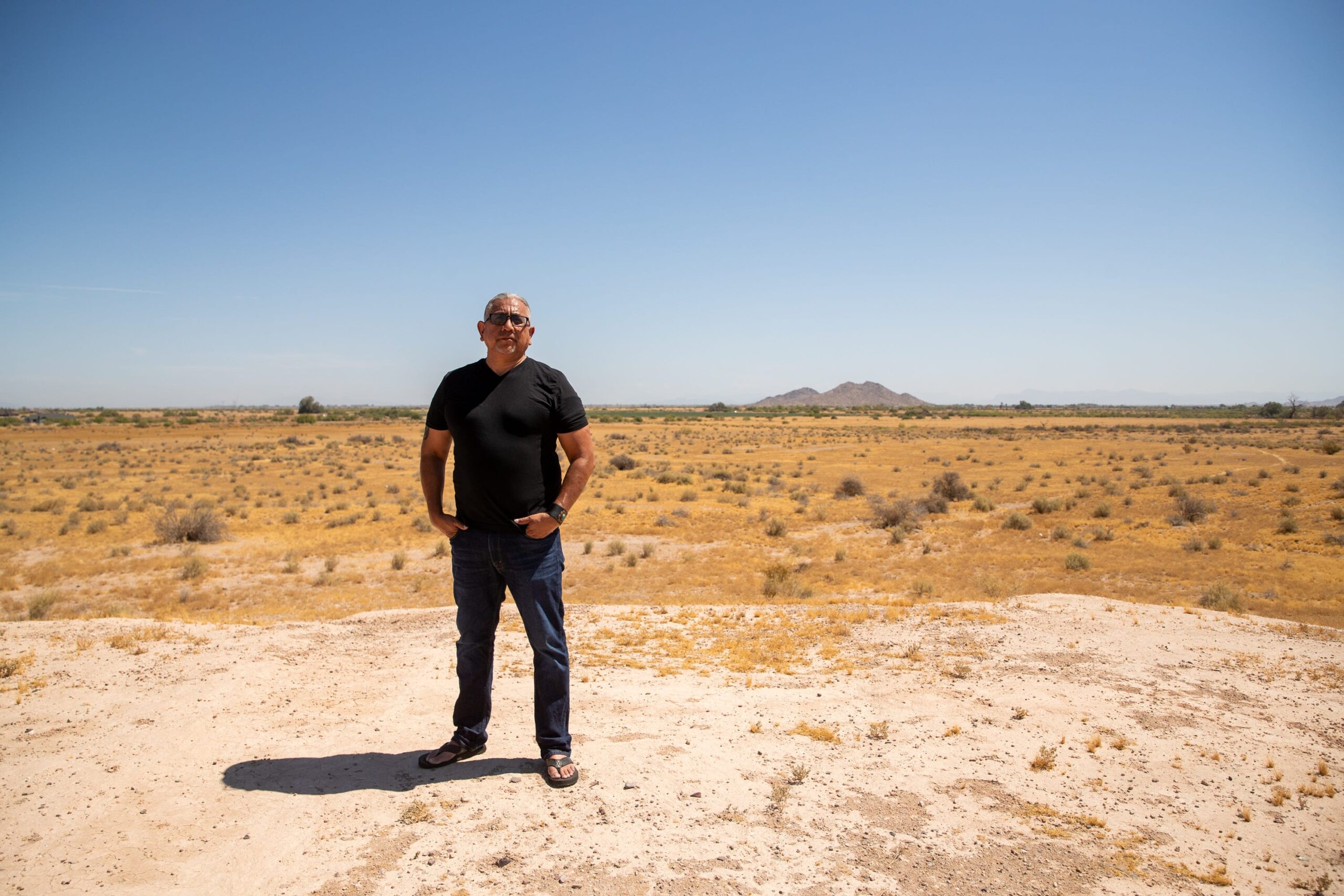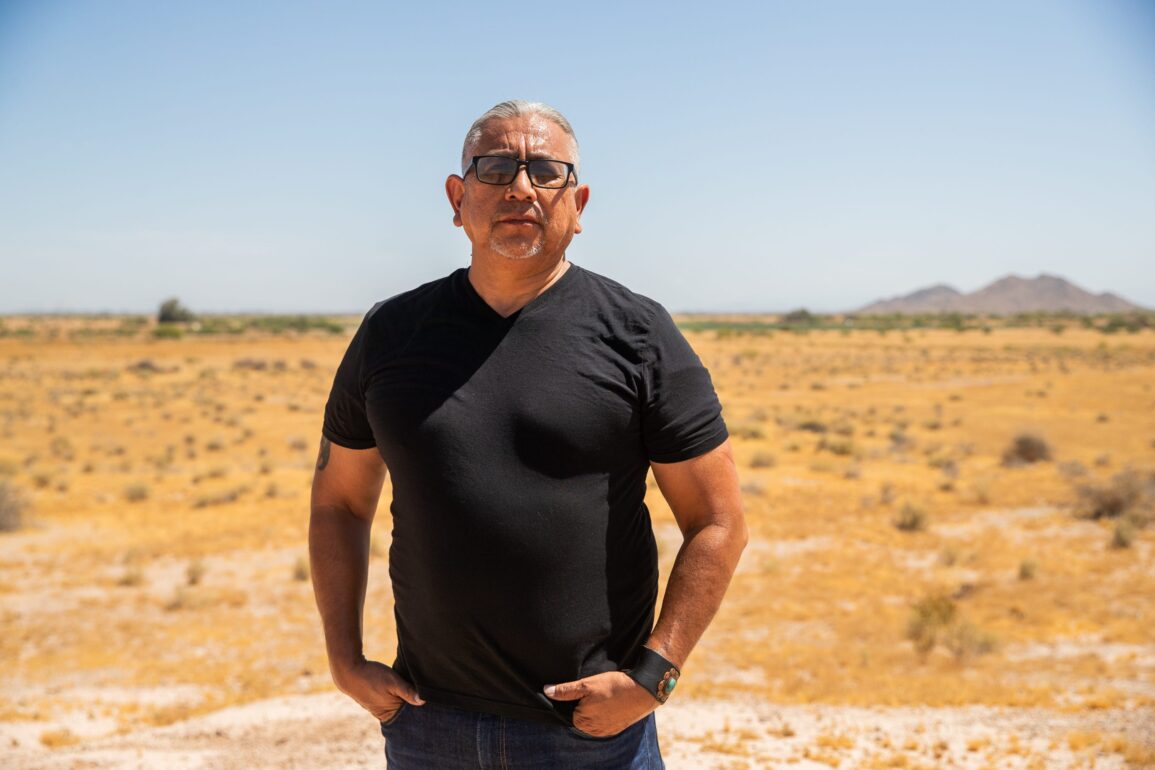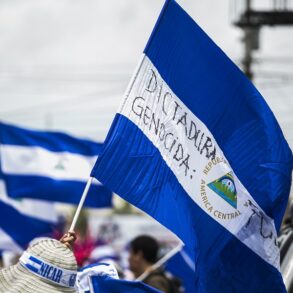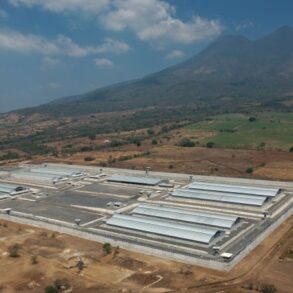
Diannie Chavez/The Republic
On a blistering morning in July, a woman stopped Shannon Rivers on his way inside a convenience store in the Gila River Indian Community. She wanted to know if he was a spiritual leader. She was in need of prayer. He was, he said, and he spent some time with her, most of it listening intently.
Rivers, 55, is tall and stocky, greying hair pulled into a long braid. He moves with a quiet authority and tends to minister to people in unusual settings, most frequently in jails and prisons across Arizona and California.
Rivers was raised in the Gila River community and is one of the Akimel O’odham, a name that means “river people.” He grew up on the same street where most of his family still live, in front of Vakhi hill.
Vakhi is a sacred site, of which the Rivers family are caretakers. It’s sprinkled with centuries-old ceramic shards, remnants of when the hill was an important gathering space in the early days of the Gila River reservation.
It’s also sprinkled with glass shards from more recently discarded beer bottles.
Rivers remembered, with a glimmer in his eye, his teenaged years drinking — and sometimes fighting — on the hill.

Diannie Chavez/The Republic
He described growing up poor, with a wardrobe of hand-me-downs from a local church. He had chafed at charity, especially when it came from people off the reservation, no matter how well-intentioned.
When he was 10, his two oldest brothers were killed on the reservation, one after another. The murders remain unsolved.
It changed him and the way he saw life in the Gila River community. He became a problem child and a bully. He started drinking and doing drugs, kicking off a long struggle with substance abuse.
“I didn’t know how to grieve properly,” he said.
The reservation can be a suffocating place. Everywhere he looked, he said he saw poverty.
“It was all in my mind,” Rivers said, “but I didn’t know it at the time.”
He was kicked out of a few high schools and spent time in jail. His substance abuse worsened. He drifted toward Los Angeles, where he had a brief period of homelessness.
“I faced a lifetime of criminality,” he said.

Diannie Chavez/The Republic
It was in Los Angeles that he encountered “urban Indians.” They were “lost or displaced” Native people who had long left their tribes or had little contact to begin with. They were a generation older than Rivers, but he found an affinity with them. They showed him a path towards sobriety.
Friends his age were dying, of alcoholism, drug addiction and gun violence.
“I didn’t want to become a Native statistic,” he said. To survive, he had to get sober.
But, he said, “it was only possible with the help of ceremony and song and tradition.”
In the late 1980s, Rivers arrived at Big Mountain in northern Arizona, the site of a protracted struggle the Navajo and Hopi people undertook to retain control over tribal land.
Congress had passed the Navajo-Hopi Land Settlement Act in 1978, partitioning land that the tribes had jointly occupied in northeast Arizona. Mining companies had long had their eyes on Big Mountain, which was rich with natural resources.
When Rivers arrived at Big Mountain, the resistance had grown into what he called a “spiritual camp.”
There, Rivers realized that spirituality and political action were deeply intertwined undertakings.
“That moment of resistance was like a light bulb going off,” he said. “I saw people who believed that the way they were — their way of prayer, their way of ceremony, their way of culture and traditions — were just as valid and just as important for their survival.”
It was experiences like this that led Rivers to become a Native spiritual leader and, later, to provide religious services for Native people who have been incarcerated. For a while, Rivers worked at Salinas Valley State Prison in California. Now, he works full-time with the Los Angeles Department of Mental Health, providing religious services as requested throughout California and Arizona.
The Indian Religious Freedom Act of 1978 guaranteed the right of Native people to access spiritual services in prison.
There are 574 federally-recognized tribes in the United States, each with their own approach to spirituality. Sometimes Rivers builds a sweat lodge, or brings drums, or learns a song. Rivers tries to tailor his approach as best as he can, though he has identified some commonalities.
Everyone, he says, is searching for “spiritual, emotional, and psychological healing.”
An unlikely opportunity to reconnect
Native people are overrepresented in jails and prisons around the country. They are incarcerated at double the national rate. Rivers sees this as the result of a long history of oppression.
“When you’re talking about incarceration, you’re not just talking about an individual,” he said. He pointed to the forced displacement of Native people and the lack of access to education and work on tribal lands.
Incarceration can provide an unlikely opportunity to reconnect with a lost heritage. Participating in spiritual services in prison can help people find context for the experiences that led them to offend.
“It helps them navigate these systems that they feel like they’re not going to get out of,” Rivers said. “More importantly, it introduces them back into a society of their culture and traditions.”
Rivers hopes that those he encounters in prison can find the same kind of solace in religion that he did. He brings his personal experience into his work.
When he goes into a prison, he said, “I recognize that these men, these women are no different than me.”
Rivers didn’t pursue higher education until he was in his late 30s. He got a bachelor’s degree at Northern Arizona University, then a master’s at University of California, Los Angeles. He wanted to better articulate what he already knew, gained through an informal education of activism and spirituality.
Nowadays, Rivers lives in Long Beach. But he returns to the Gila River Indian Community often. On his most recent trip, he showed The Arizona Republic another important site: a memorial for the Japanese internment camp constructed on Gila River.
After World War II ended and Butte Camp was vacated, the tribe decided to tear down its buildings. On top of a nearby hill, next to the old water tower, there’s a curving line of white columns.
Rivers sees Japanese internment as another entry in a long history of American incarceration — and yet another reason why collective struggle is necessary.
This post was originally published on this site be sure to check out more of their content.







